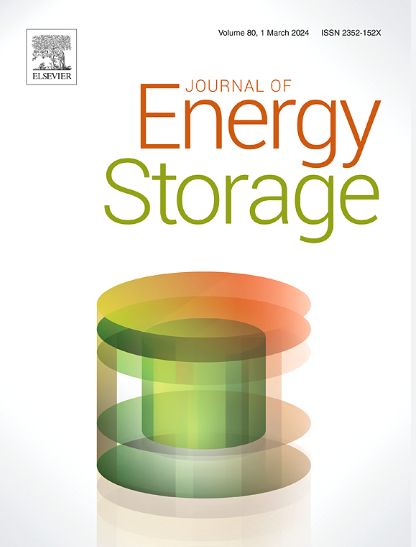相变材料大封装的大型100 MJ级联填充床蓄热系统热性能实验研究
IF 8.9
2区 工程技术
Q1 ENERGY & FUELS
引用次数: 0
摘要
虽然相变材料(pcm)具有很高的理论储热能力,但其在热储能(TES)系统中的实际性能通常受到诸如温跃层、截止温度和操作时间等操作限制的限制。为了解决这些挑战,本研究引入了一种新的宏观封装方法来制造具有耐高温和防泄漏完整性的8600不锈钢PCM胶囊。利用这种方法,我们建立了一个100 MJ级联填充床TES系统,并在实际操作条件下系统地评估了其热性能。随后的实验分析比较了不同进口温度和出口截止阈值对充放电效率的影响。实验结果表明,在充电过程中,在TES装置工作范围内提高进口温度,不仅可以提高储热能力,还可以提高储能效率。例如,将进料口温度从120℃提高到180℃,储热效率从70.4%提高到97.3%,有效储热密度从21.43 kWh/m3提高到53.77 kWh/m3。反之,在排气过程中,降低进口温度不仅能提高排气功率,还能增加放出的热量。为了充分释放储存的热量,排气入口温度应低于TES设备内PCM的最低相变温度。放电截止温度由实际应用场景决定,截止温度越高,对放电过程出口温度的要求越高,放出的热量越少,蓄热密度越低。本研究对储热利用具有一定的适用性,为填料床TES系统的实际设计提供了有价值的参考。本文章由计算机程序翻译,如有差异,请以英文原文为准。
Experimental study on the thermal performance of a large 100 MJ cascaded packed-bed thermal energy storage system with macro-encapsulation of phase change materials
While Phase Change Materials (PCMs) offer high theoretical heat storage capacity, their practical performance in Thermal Energy Storage (TES) systems is often limited by operational constraints such as thermocline, cut-off temperatures, and operating time. To address these challenges, this study introduces a novel macro-encapsulation method to fabricate 8600 stainless steel PCM capsules with validated high-temperature resistance and leak-proof integrity. Using this method, we established a 100 MJ cascaded packed-bed TES system and systematically evaluated its thermal performance under real-world operating conditions. Subsequent experimental analysis compared the effects of varying inlet temperatures and outlet cut-off thresholds on charging/discharging efficiency. Experimental results indicate that during charging process, increasing the inlet temperature within the TES device's range not only enhances thermal storage capacity but also improves energy storage efficiency. For instance, raising the charging inlet temperature from 120 °C to 180 °C increased thermal storage efficiency from 70.4 % to 97.3 %, with effective thermal energy storage density rising from 21.43 kWh/m3 to 53.77 kWh/m3. Conversely, during discharging process, reducing the inlet temperature not only enhances the discharge power but also increases the released heat. To fully release the stored heat, the discharge inlet temperature should be below the lowest phase-change temperature of PCM within TES devices. The discharge cut-off temperature is determined by practical application scenarios, with higher cut-off temperatures imposing stricter requirements for outlet temperature during discharging process, resulting in less released heat and lower thermal energy storage density. This work has applicability in thermal storage and utilization contexts and serves as a valuable reference for the practical design of packed-bed TES systems.
求助全文
通过发布文献求助,成功后即可免费获取论文全文。
去求助
来源期刊

Journal of energy storage
Energy-Renewable Energy, Sustainability and the Environment
CiteScore
11.80
自引率
24.50%
发文量
2262
审稿时长
69 days
期刊介绍:
Journal of energy storage focusses on all aspects of energy storage, in particular systems integration, electric grid integration, modelling and analysis, novel energy storage technologies, sizing and management strategies, business models for operation of storage systems and energy storage developments worldwide.
 求助内容:
求助内容: 应助结果提醒方式:
应助结果提醒方式:


